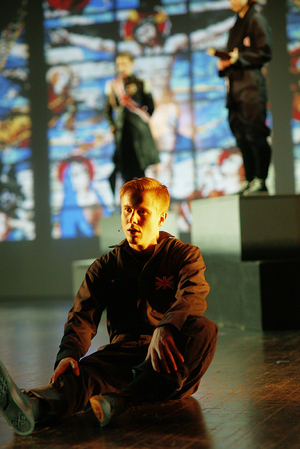BWW Blog: Let's Get Physical: What I Learned from My First Physical Theatre Experience

in Hart House's
Oh, What a Lovely War.
Photo: Scott Gorman.
When I walked into the audition room for Oh, What a Lovely War (the fourth and final show of Hart House's season), I was expecting that the production would be a remount of the beloved Joan Littlewood First World War satire musical from the 1960s. After all, I had prepped some new songs with my vocal coach, trying to change my vocal mentality from contemporary ballads to gritty trench songs. Once I was cast in the piece and we had our first script read through, I learned that director Autumn Smith's version would be told from a 2020 lens, including video projection, virtual reality and several battle reenactments.
Physical theatre is usually defined as storytelling that uses movement to drive the narrative. There is room for classic theatre conventions like text, song and set design, but in physical theatre pieces, the actors use their movement to set the scene and push the plot.
This was a bit of a departure from the theatre I've previously done in Toronto. I was very much used to getting a script and libretto from MTI, and having a point of reference to draw from. Although I had already worked on original plays, a reimagined musical told via physical theatre conventions was something I hadn't ever anticipated doing (at least not so soon into my career). Here's some of what I learned about physical theatre throughout the rehearsal process and the run:
1. Playing with Proximity
So many times as an actor I've thought I've been a bit "detached" from a role. Being zoned in on stage at all times is something that takes years to master, and as I'm still in the training portion of my acting career, it's something that I grapple with every time I'm given a new part. But physical theatre seemed to ground me more into my role. Since our set was fairly influenced by audio cues and video projection, being able to create and pretend became all the more important. Having to imagine and simulate different settings throughout the piece brought me closer to my character and forced me to make tough character choices as a response to the realities of the set. It taught me that you don't always need complex set pieces to make a story come to life. There's something special about getting to create with a set of drama boxes, great audio-visual cues and only the most essential props.
2. Pacing Yourself
I joked with friends that the show was like a "track meet". Although the show's total runtime was only two hours, we were working incredibly hard throughout. Without the ability to leave the stage for a breather or a sip of water, timing out our movements and exertion level helped make sure that we had enough gas for the moments in the show that needed it. At one point in the second act, my character has to sing an acapella solo after a high-paced box jumping formation. During the dress rehearsal, I realized that taking the extra five seconds to calm my breathing before I sing made all the difference. Listening to your body, even for a handful of seconds, can help you navigate the up and down nature of physical theatre.
3. Working as a Unit
Probably the single most important aspect of the show was cast unity. Our version of Oh, What a Lovely War was ensemble-driven, with a male and a female ensemble of six performers each. Everybody needed to be on the same page when it came to creating and reinforcing the video game world we were stuck in. In the second act, the male players climb over the female avatars as if they are painstakingly working their way through barbed wire in No Man's Land. If even one of us doesn't understand the intention behind the scene, the overall cohesion of what we're trying to create can be lost. This led to a number of constructive conversations among cast members regarding a consensus viewpoint for each scene. Being in a rehearsal room and discussing overall cast intentions (rather than individual ones) was a special moment and one that has already influenced how I think about character creation and actor intentions. It also sheds some light on what the best of theatre can be: a group of performers working together to create a piece of art, rather than against one another.
We closed the run of the show on March 7th, to some amazing crowds that gave us some great insight during the talk-backs with the cast and creatives. I feel extremely fortunate to have been a part of a physical theatre piece that pushed me to my limits physically and made me re-imagine what it means to perform in a track on stage. This show wasn't what I expected when I walked in the audition room, but by the end of the run, I realized how special it was to my development as a performer.
Comments
Videos


